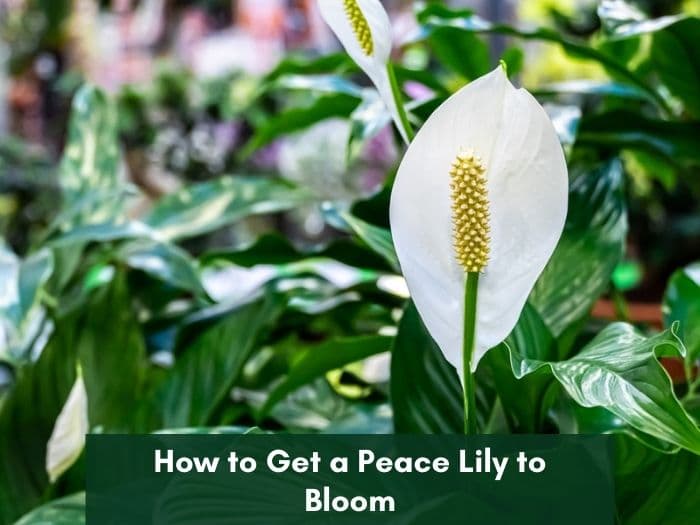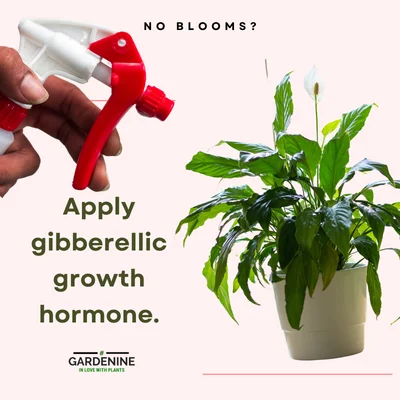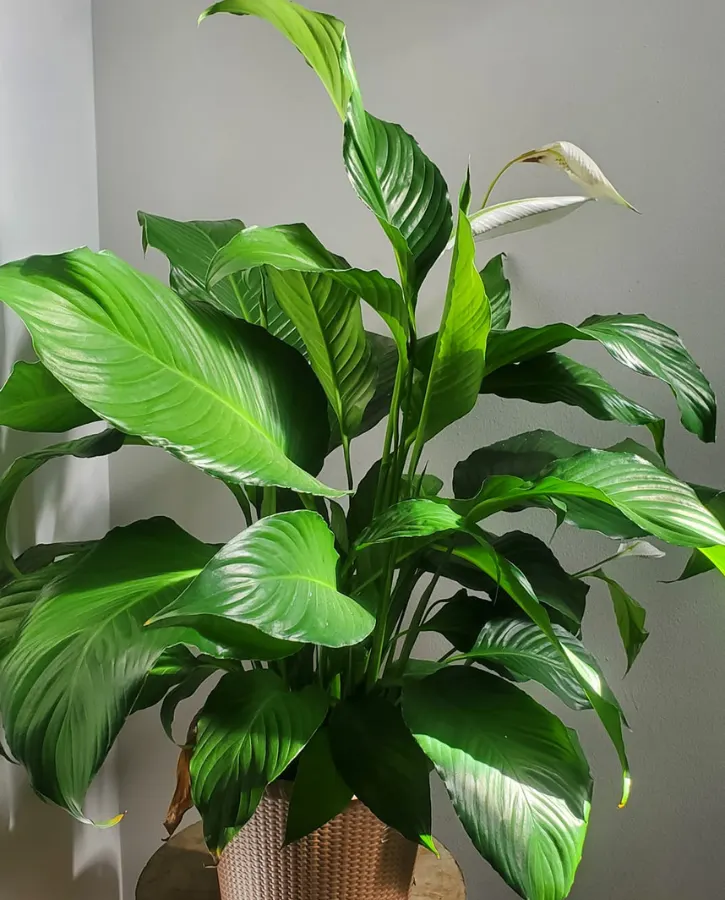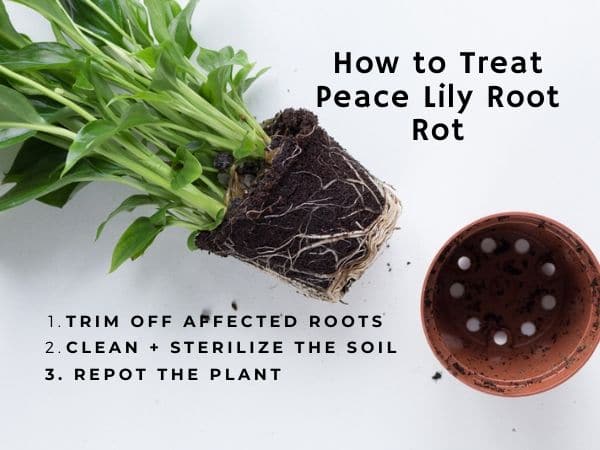Peace Lily Not Flowering: Causes + How to Make it Bloom
Peace lilies (Spathiphyllum) produce white flowers repeatedly when growing in optimum conditions. With proper care for your peace lily, the plant will naturally bloom in spring.
However, there are times when the plant won’t bloom despite your best efforts. So, why isn’t your peace lily flowering, and how can you fix it?
The main reasons for a peace lily not blooming are insufficient light and nutrients, poor watering, and old age. Ensure the plant gets bright indirect sunlight and keep the soil moist to make it bloom. Applying a balanced fertilizer 2-3 times during the growing season will also help it flower.

If your peace lily isn’t old but has not produced any flowers for years, I’ve explained below what you can do to diagnose and fix the problem.
Why peace lily is not flowering – with fixes
While peace lilies, like many flowers, are expected to bloom in the spring and early summer, sometimes they’re erratic at it and may not bloom at all, or bloom way later than usual.
Here are the reasons why peace lilies may not bloom:
| Reason for not blooming | Fix |
| Insufficient sunlight | Provide 6 hrs of bright indirect sunlight |
| Erratic watering | Keep soil moist (not soggy) |
| Nutrient deficiency | Apply soluble organic fertilizer |
| Small pot | Repot in a pot 1-2 inches bigger |
Insufficient light
The main reason for not blooming is insufficient sunlight. Peace lilies growing indoors in dark areas are highly unlikely to bloom.
Best fix:
Peace lilies prefer bright indirect sunlight. Place the plant near an east-facing window so it can receive 4-6 hours of indirect sunlight daily. A north-facing window is also ideal but place the plant a little farther away to prevent sunburn.

Too much light can stress out peace lilies, while too little light is not enough for adequate photosynthesis.
Inadequate watering
Erratic watering habits such as overwatering and underwatering affect the growth of peace lilies. The plant will droop to signify its unhappiness or root rot disease and may not produce any flowers.
Best fix: Water your peace lily enough to keep the soil moist at all times. A proper watering schedule and gentle light and warmth provide the ideal conditions for a peace lily to flower when the right time comes.
Inadequate water means nutrients cannot be translocated throughout the plant. Sometimes, lack of water can cause peace lilies to wilt and droop easily.
Here are tips for watering your peace lily and helping the plant flower:
- Water the plant once a week, but wait for the top 1-2 inches of the soil to dry out between waterings.
- Keep the soil in the pot moist, especially in the root zone.
- Ensure the container has drainage holes to prevent your peace lily from sitting in soggy soil.
Lack of nutrients
If your peace lily is not getting adequate nutrients for cell division, it will not bloom. Other symptoms of malnutrition include stunted growth and curling leaves.
Soil pH problems affect nutrient availability and absorption, so you want to check that to ensure it is within the preferred range.
Best fix: Test the soil using a pH test kit to ensure the pH range is between 5.8 to 6.5, as preferred by peace lilies. If not, correct the pH and feed the plant with a balanced organic fertilizer such as MiracleGro All Purpose Water Soluble Plant Food to encourage blooming.
Alternatively, any 20-20-20 organic fertilizer will be great for peace lilies growing indoors.
Temperature problems
Peace lilies prefer warm climates. They will not produce flowers when it is too cold (during winter) as the buds die off.
Best fix: Maintain a temperature range of 68-85 °F for your peace lilies to stimulate blooming.
Very hot conditions mean the plant loses a lot of moisture too fast, which impairs its growth and development. That’s why it may fail to bloom.
- Keep your peace lily away from heated vents and radiators.
- Peace lilies don’t like cold, so keep them away from cold drafts such air conditioning vents.
The pot is too small
Although peace lilies like to be rootbound, it is possible yours isn’t flowering because it has outgrown the pot. The plant will exhibit other unpleasant symptoms, such as weak overcrowded foliage and frequent droopiness even when the soil is moist.
Best fix: Repot your peace lily in a pot 1-2 inches bigger than the current one. Use a well-draining potting mix that contains perlite or sand to encourage proper drainage.
You’ll know your peace lily needs repotting when you see roots ‘peeping’ through the drainage holes in the pot. The presence of a hard mat of roots on the surface of the soil is also a sign the plant needs repotting.
Your peace lily is old
Aged peace lily plants will rarely bloom. They may also be characterized by other symptoms, such as leaf yellowing that occurs too soon after the leaf emerges.
This leaves the plant with poor nutrition that impairs its optimum growth leading to failure to bloom.
If your peace lily is not flowering, you might want to check its age to rule out this reason. Young peace lilies are expected to bloom at least once a year if they’re provided with optimal conditions for growth and development.
The plant is too young to bloom
Sometimes, failure to bloom after you buy the plant could be caused by the peace lily being too young to produce flowers. If you bought your plant with a spathe or white flower, chances are that it was forced to bloom.
Commercial plant nurseries often use gibberellic acid, a potent hormone that controls the growth and development of plants. The effects of this hormone include increased stem, leaf, and root growth. Young peace lily may have been forced to bloom with gibberellic acid.
Other ways to get a peace lily to bloom
Proper plant care is enough to make a peace lily produce flowers yearly. Cultural care and maintenance practices such as timely pruning of peace lilies, correct watering, lighting, and temperature control can help the plant bloom easily.
Here are other tips to get a peace lily to bloom regularly:
1. Try gibberellic acid
If you’ve tried all the natural ways to make a peace lily flower but to no avail, hormonal therapy might be your best option to make the plant bloom.
Buy a gibberellic acid and feed the peace lily with it in the form of a spray on the leaves or rooting culture in the rooting zone.

This will speed up the flowering process, especially if the plant is old. It is also a great way to force peace lilies to bloom faster if they are young.
2. Place the plant outside
Peace lilies may never bloom if placed in rooms with low light conditions. While they can grow and thrive in rooms with no windows, these plants may not produce blooms even upon reaching maturity.
The best fix is to migrate your peace lilies outside where they can receive bright indirect light. I recommend placing them on the front porch to encourage them to flower.
3. Prune the peace lily
For overgrown peace lilies without blooms, prune the excess foliage and stalks after the blooms fade and wilt to maximize nutrient efficiency and make the plant bloom a few times every year.
FAQ
How often does peace lily bloom?
Peace lilies can bloom up to two times a year if the growing conditions are optimal. The white flowers appear in the spring and also in the fall. However, it is normal for the plant to bloom just once a year.
How to make a peace lily flower again
The best way to make a peace lily flower again is to prune and remove the spent flower and its stalk as soon as you see signs of wilting or browning to allow new blooms to emerge. Also, provide bright indirect sunlight and keep the root zone moist to make the plant flower again.
If the plant has already flowered in the spring, you might have to wait until the next season for it to produce flowers. You shouldn’t expect the blooms to appear soon after the previous ones wilt, as it might take a few months from spring for the peace lily to bloom again.
Can a peace lily bloom all year?
Peace lilies can bloom all year if they’re force-bloomed using gibberellic acid, which speeds up cell division and elongation.
References
Leonard P. Perry, Extension Associate Professor, University of Vermont: Why Plants Fail to Bloom







